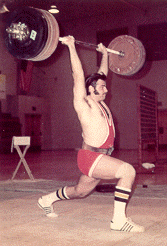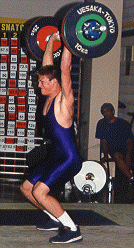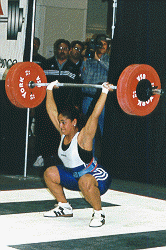LEARNING THE BASICS
A JERK IS A JERK!!!!!!!
By: J.V. Askem
QUESTIONS:
What is the different between a Push Press
and a Push Jerk?
And, what is the difference between a
Jerk and a Push Jerk?
These two questions come up occasionally, and
even though I address this subject briefly in my article "The Power Clean
and Push Press", there still seems to be some confusion as to what a jerk
really is! So, the objective here is to clarify that confusion.
Now, when I say "A Jerk is a Jerk", I'm mainly
referring to the "Jerk" portion of a Clean and Jerk done in an Olympic
style weightlifting contest. Simply put, it does NOT matter how you perform
the "jerk" portion of the lift when in a contest environment! In reality
Olympic lifters perform three methods of jerks, Split, Power, and Squat,
and the style used is simply the personal preference of the individual
lifter.
THE SPLIT JERK

Yours truly doing a split jerk
during my competition days
in the 1970's.
The most common of the three methods of jerking
is the "split jerk", and as a weightlifting coach this is the method I
prefer! The main reason I lean toward this method is that it affords a
lifter more chances to adjust under the bar!
When lifting an "all out" effort, the bar doesn't
always go where you want it to! Example, if you don't drive or push hard
enough with your legs, the bar will not elevate high enough. But you can
still save the lift if you drop lower than you may have planned to receive
the bar at the locked out position overhead. Also sometimes the bar goes
upward on a angle. Thus a good long split will afford a lifter an opportunity
to pivot on the front and back leg to get to a lower position, or to adjust
forward and backward. This can not be done effectively with the other two
methods of jerking.
THE POWER JERK (more commonly called a push
jerk)

Bristol Marunde power
jerks one of his attempts
in a contest.
First off, in my opinion, I think the terminology
"push" jerk is a stupid term!!! I say this because all methods of jerks
are driven or pushed up with the legs exactly the same way. So why just
call one method "push" when the other two methods also push?
The correct term is "power jerk", and like
the power clean, a "power jerk" exemplifies minimal dip with the legs to
receive the bar overhead! You simply dip your knees to drive the bar up,
then quickly perform a second dip (about a quarter overhead squat) to receive
the bar at the arms' locked out overhead position.
Now the big drawback to doing power jerks in
a contest comes if you don't drive or push the bar high enough! Also if
you don't have the flexibility or speed to squat lower than that quarter
overhead squat! If this is the case then more than likely your lift will
fail.
In the above picture, one of my protégés
Bristol Marunde is shown doing a power jerk. However, he received a couple
of red lights because of press outs on his power jerks, simply because
he had no room to make an adjustment under the bar. When he switched to
split method, he did much better with his jerking.
Power jerks are OK as an assistance exercise,
but to lift the really big weights the split method is better! Example,
my best split jerk was 375 lbs, but the best I ever did on a power jerk
was only 310 lbs.
THE FULL SQUAT JERK

Cara Heads-Lane performing
perfect full squat jerk with 275 lbs
for an American Record in the
women's 75kg class, at the 1999
American Open WL Championships.
Now, a problem of an insufficient leg drive
can also be solved with a deep squat style jerk
(a la Cara Heads-Lane), but the problem here
is that one's shoulders must be very supple. And such shoulder suppleness
is rare. Also, if you have this type of suppleness in the shoulders, you
will more than likely lack prime mover (raw pressing) strength in your
shoulders. In short, you will have to give up something to gain something!
Full squat jerks were virtually non existent
years ago when Olympic lifters did a lot overhead presses, simply because
all that prime mover shoulder work tightened up the lifters' of that era
shoulder girdles . Today's Olympic lifters don't have the prime mover shoulder
strength that the old timers had, simply because it isn't required anymore.
Finally, the deep squat jerk does NOT allow
you the ability to pivot back and forth if the bar gets slightly behind
or forward. When squat jerking the ideal situation is to dip your knees
and drive the bar straight up. Then, as the bar is elevating upward, you
just squat straight down under the bar until the bar is locked out overhead
at arms length. However in the real world sometimes the bar gets out of
the groove forward or backward. And when this happens a full squat jerk
fails.
HOW TO EXECUTE A JERK!!!
Once you've racked the bar on the shoulders
after a clean. Take about 3 to 5 quick breaths. Don't stand there too long,
but don't rush the lift either. Look up slightly at about 30 to 45 degrees.
Try to fix your eyes on a specific spot on the wall or ceiling. The reason
for this is, that when you dip your knees, you will want to drive the bar
straight up in a straight line. Also you don't want to hit yourself in
the chin or nose as the bar elevates.
Don't dip your knees too much to drive the
bar! 3" to 4" should be enough. Dipping or squatting too deep will have
a tendency to force you lean forward, and this will force you to drive
the bar up at an angle forward of where you would want to receive it at
arms length.
Except for the power jerk it is not necessary
to drive the bar up much higher than your forehead to jerk it! It's the
foot and leg speed in going under the bar, plus a strong lockout, that
makes for a successful jerk. When you receive the bar at arms length, move
your head forward under the bar. At this point you will want to be looking
straight ahead not up. Also you will want your arms right in line with
your ears.
When recovering from a split jerk, step back
first on the front leg about half way. Then bring the rear leg in line
with what was the front leg. When recovering from power and squat jerks
you just stand straight up.
Best of luck with your training. JVA
BACK
TO "LEARNING THE BASICS" INDEX
TO THE
CABLE/ BAR GUY'S HOME PAGE


